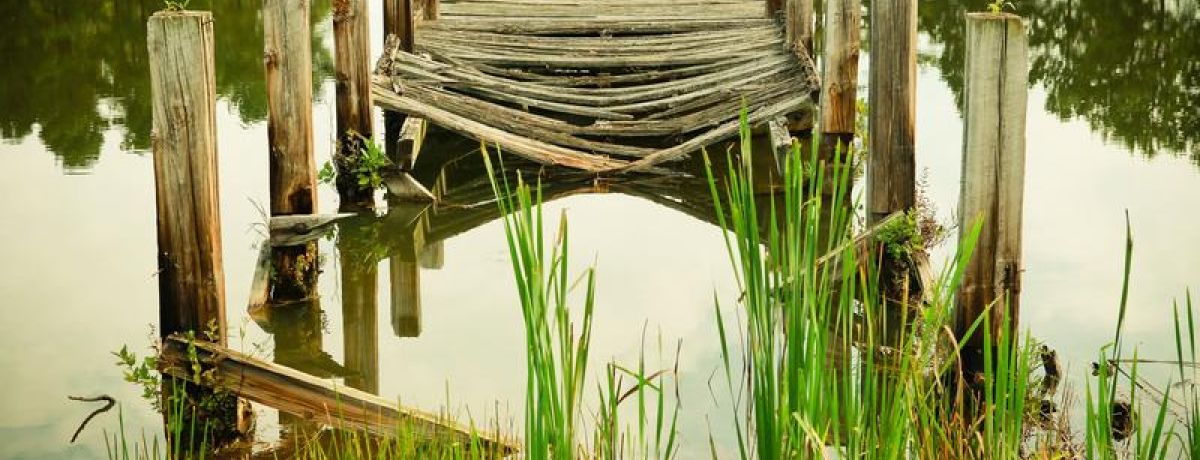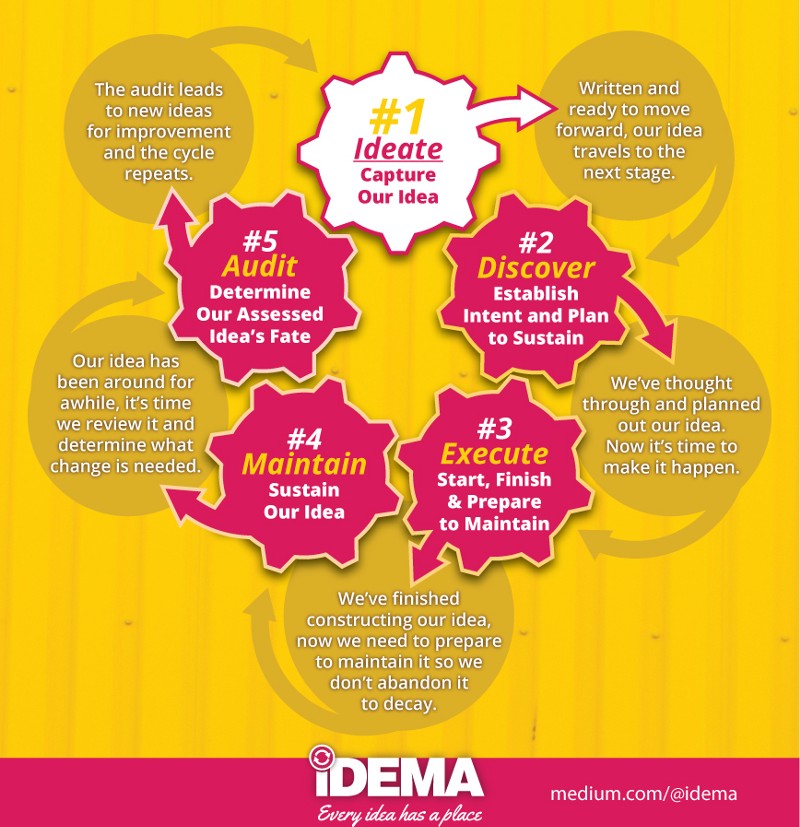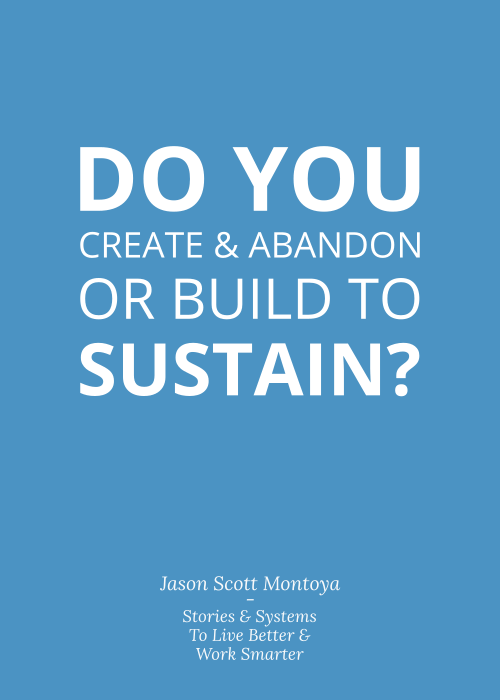
Do You Create & Abandon or Build To Sustain?
When you create and launch projects, campaigns or companies do you do so with intent and a plan to sustain or do you simply create and walk away?
In my experience as a business owner, and working with other entrepreneurs, it’s quite rare for sustaining to take priority. Usually, visionary owners want to create and move onto the next thing without a second thought. Some will even abandon their business as they explore some shiny object with mixed results (based on who is left behind).
Unfortunately, this approach leads to a wreckage of broken and abandoned ideas. In these situations, the only things getting maintained are projects team members care for or that clients complain about.


The Cost of Unintentionally Abandoning Our Creation
The cost of inadvertently abandoning varies based on the scope and length of time the idea has been neglected. I remember when Noodlehead Marketing came across the shiny object of Bluetooth proximity marketing devices. We spent several months packaging, promoting, and selling them. We even had a meeting with IHG about selling these devices. Unfortunately, the technology was not far enough along and had more problems than benefit. We weren't able to get enough traction to justify the ongoing effort, so we intentionally abandoned it to refocus on our primary business services.
After we refocused towards our main offerings, I quickly realized how bad of an idea this distraction had become. Our main pipeline of building websites and helping market companies was severely neglected. Now the bills were coming in and we had to ramp things up quickly to catch up the business.
But this wasn’t the only shiny object I chased or thing I got bored with. During the first several years owning my marketing company, we were serially creating projects. I had multiple websites, landing pages, social channels and even a YouTube video series called Pasta Salad (about internet marketing tools). There were also internal wikis, project management systems, and CRMs. In many cases, we would launch a project abandon it, forget and then do it all over again without memory of our previous effort. If only we had sustained the first time around, we would have made strides of progress!
Somewhere along the way, I decided to make a list of everything going on in the company, active or abandoned. As several hundred items accumulated on this list, for a small company of fewer than ten people, I quickly came to realize my pattern of creating and abandoning, and it wasn't fruitful. I seriously struggled to finish and sustain. The result was a littered path of people, projects, and ideas. All that wasted time, money and relational equity squandered. We were fast, but our approach prevented ever building up velocity.
Visionaries create and move on. Very few spend the time creating to sustain. When we treat what we build like we would an actual garden, we’ll easily see the parallel of creating to sustain.
Thinking of what we create as living, helps remind us how we need to give our plans sunlight, water, and soil to flourish. Like a garden, our ideas, projects, and processes need attention and resources to continue. The success we desire requires less energy, but more focus and discipline. At the core of it, struggling with these two realities is much of what drives us away from the mundane act of maintenance.

Leveraging The IDEMA Framework For Sustaining Ideas
As perpetrators and victims of not planning to sustain, we at Noodlehead Marketing faced the consequences and this driving factor was why we chose to incorporate the idea of including maintenance planning during the discovery phase in the IDEMA framework.
By simply asking ourselves, what resources it will take to keep the idea and project alive, we’ll get a pulse check of what that entails. Entrepreneurs usually minimize the ongoing cost and effort while operational folks will paint the effects more severely. A balance of the two while also leveraging data provides a realistic picture of what to expect.
Here are four additional maintenance questions to ask when planning your next project.
- What actions will be required to maintain this idea? How often will they need to be done?
- Who will make decisions on the project’s maintenance?
- Who will be responsible for moving the maintenance actions forward?
Three Real Examples of What It Looks Like To Create & Sustain
How does this play out in our lives and work? Let me share three examples to help inspire ideas on where you can grab onto the mindset of planning to sustain.
1 - How Website Maintenance Neglect Leads To Big Problems
For four years as a freelancer, and seven owning a marketing company, I've project managed and built Joomla websites. Since then, dozens of my client's websites were hacked as the result of them not upgrading their CMS software. In many cases, they didn't actively run backups, so it made restoration challenging (or in some cases impossible). It's why I offer a backup, update, and restoration service as part of my offering since most companies will neglect this important little detail.
In addition to security, website content also ages and links change. While these two items are not the only elements that lead to a website decaying, the point is that the responsibility of creating a website spans beyond simply building and launching it. Time and resources must be dedicated to keeping it current.
I've got a client who has built their custom online ERP system over the last decade. During the course of that time, the number of code lines has grown but the development staff has not. At some point, the team will no longer have the capacity to build new projects and will be entirely dedicated to addressing bugs and keeping core functionality running. By the time this happens, it'll be extremely difficult to expand the team or launch new projects.
Ideally, a decision maker understands the reality of what's required to sustain before they begin the construction (as opposed to when the project is complete).
2 - Blogging With An Asset Mindset (It's Not Trash)
If there’s one thing worth creating serially without looking back, it's an ongoing blog. While it will still eventually decay and break, it’ll provide significant benefits along the way. I'm working with a client who had a generous blog archive of over 700 articles. This effort was a vital asset for driving large volumes of organic traffic to his website. Unfortunately, the content decayed, becoming outdated with broken links. In other cases, there were multiple articles on the same topic ripe for consolidation, which is what my freelance team and I have been working on with this client.
The same is also true here on my website here. I've been recently working on updating my services page and I'm aware how much my about page needs an update. Every blog I publish is also subject to future updates. As part of my writing and blogging process, I have a system for capturing improvement ideas for each blog so when I revisit them, I can quickly implement the changes. There are also 43 broken links across my archives that need correcting and other items on my maintenance todo list. While I have limited capacity to maintain, I do slowly and surely work through the items to move forward. Simply put, as this blog grows so will the amount of time it requires to keep it excellent. Streamlining my processes is one way to address this, but at some point, I'll need to dedicate more time or hire help to steward it well.
3 - Staying Active As A Freelancer When Things Are Good
Freelancing is not easy and simply focusing on the paid project in front of us is not enough to make the path work. When it comes to maintaining my freelancing career, I identified eight achievements required to do this well (the framework for my first book, Path of the Freelancer). For quick reference, here's the list.
- Fully Committed To Freelance
- Offerings In A Compelling Package
- Steady Stream Of Paying Clients
- Maximize Active Clients
- Escape The Roller Coaster
- Wise & Precise Financial Management
- Unified Personal and Work Lives
- Share What We’ve Mastered
When you share where you as a freelancer are struggling, I can quickly identify which of the above achievements you're failing to sustain (and so can you!). Even with the steady success I've had as a freelancer, I need to stay active outside my paying clients. This usually tends to include activities that are less urgent, but important to long-term flourishing.
Blogging here on my website allows me to promote myself while also sharing what I've mastered as a significant way to help others. To minimize the weight of seasons of feast and famine, I work with customers in an ongoing capacity, build a financial reserve, and engage with a meaningful community.
Plan & Execute With The Intention To Sustain What You Create
Whether it is our relationship with kids, our marriage, the team's health, the house, or cars, maintenance is vital to thriving together. When we make decisions, especially the big ones, it's vital to the long-term success that we understand and commit to the entire iceberg (not just the tip).
Doing so requires we plan and execute with visibility on what's expected to sustain. By knowing and experiencing the cost and benefits of doing it this way, it'll be hard to do it any other way. The IDEMA framework is a great way to bring this mindset into your organization.

Additional Resources
Hero Photo by Tom Butler on Unsplash